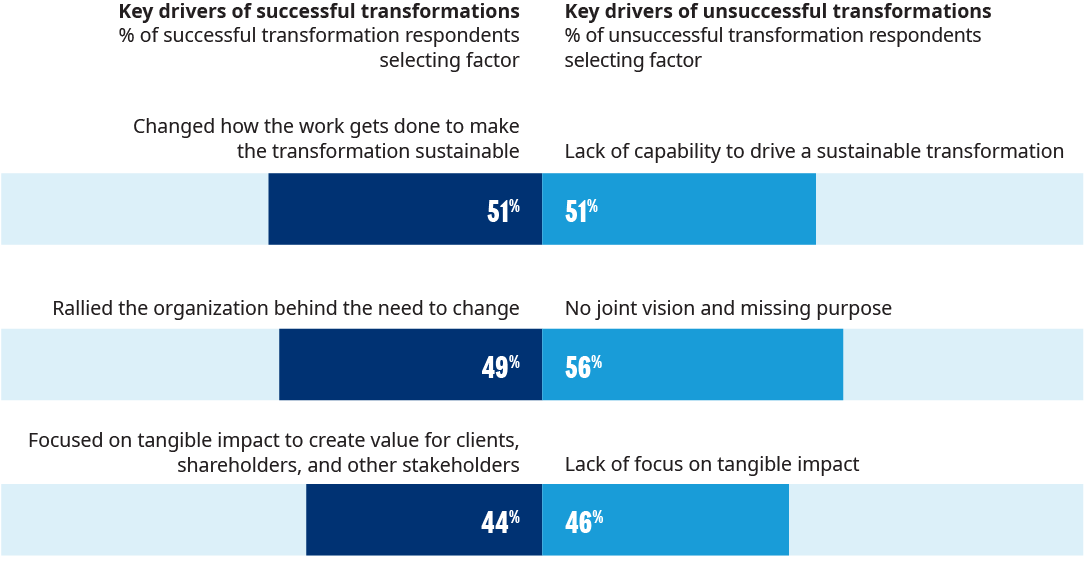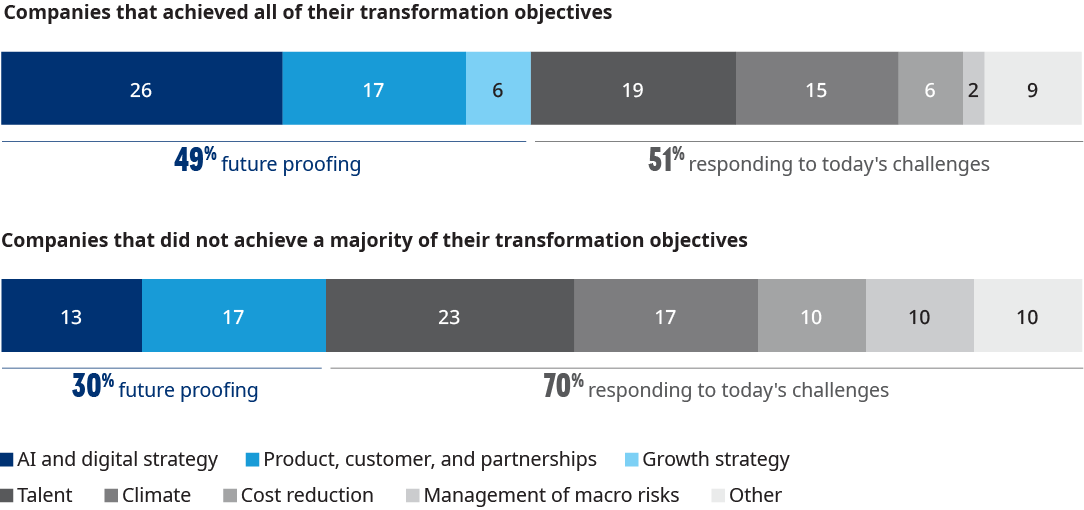Today’s dynamic global business environment presents organizations with many challenges. Opinions on the market outlook are split, reflecting a high degree of uncertainty, causing executives to set out on ambitious transformations to right-size costs while pursuing future growth opportunities.
To understand what makes business transformations successful, we surveyed more than 240 C-suite executives from leading companies across industries in the Americas with the primary goal of answering what differentiates successful transformations from the rest.
Key differentiators between successful and unsuccessful transformations
Our survey revealed that 100% of executives have attempted a business transformation in the last three years. However, success remained elusive, with only 25% of companies fully achieving all their objectives.
 The mere 25% that succeeded used cost efficiency as fuel for their growth objectives, and fundamentally changed the way their organization worked to make their transformation sustainable in the long term
The mere 25% that succeeded used cost efficiency as fuel for their growth objectives, and fundamentally changed the way their organization worked to make their transformation sustainable in the long term
Firms that succeeded in their transformation effort implemented a more holistic approach than their counterparts whose efforts were unsuccessful.

 Companies that succeeded invested 31% more in their transformation efforts, on average, than unsuccessful companies
Companies that succeeded invested 31% more in their transformation efforts, on average, than unsuccessful companies
Several key themes emerged from the survey, allowing us to distinguish what separates fully successful transformation efforts. Companies that succeeded focused on tangible impact to create value for clients, shareholders, and other stakeholders; changed how they worked to make their transformations sustainable in the long term; and rallied the organization behind the need to change. By contrast, businesses with unsuccessful transformations, that did not achieve their objectives, reported having inadequate focus on tangible impact, a lack of capabilities to drive a sustainable transformation, and no joint vision or purpose behind their transformation effort. Those that fully achieved their transformation objectives have created headroom in their cost structure to fund their future growth, which will be critical in an uncertain market.

Outlook over the next 12 months
While companies must adapt to the changing market environment to persevere in a highly disruptive environment, most will need to rethink their strategies to improve their odds of success.
Companies that succeeded were much more likely to prioritize their AI and digital strategy (26%) for the next 12 months compared with those that didn’t meet their transformation objectives (12%). Those less than successful are not expected to focus on growth strategy; they still need to revise internal operations and adjust their talent.

Industry leaders further validated our prior experiences
The key elements of successful transformations that feature in these results are consistent with Oliver Wyman’s experience in end-to-end transformations. In particular, we see clear parallels to our Seven Truths Of Transformation — a set of practical principles to drive enterprise-wide change that we have honed hand-in-hand with clients over the years.
Our Conclusion
In summary, companies with successful transformations were primarily motivated by growth as opposed to cost-cutting, as seen through genuine efforts to add client, shareholder, and customer value; a desire to achieve long-term transformation efforts; and championing change. These companies were willing to fundamentally change their ways of working and create an internal company environment that allowed them to focus on the future with more ease and certainty. Before embarking on a transformation journey, executives need to be fully aware about what makes transformations successful and how to avoid pitfalls, in order to achieve lasting results and position their companies for top-line growth.


